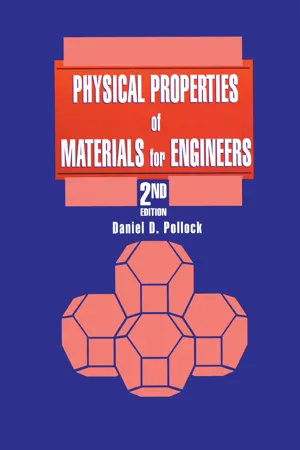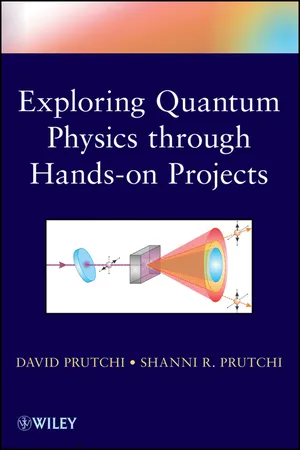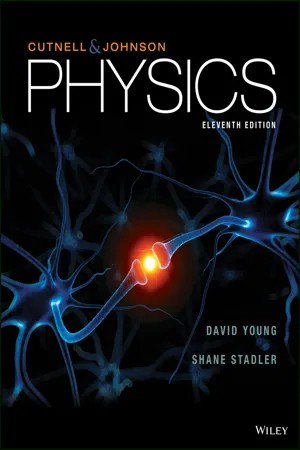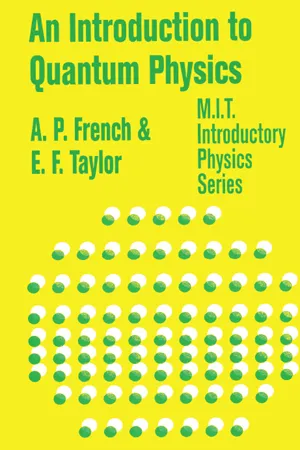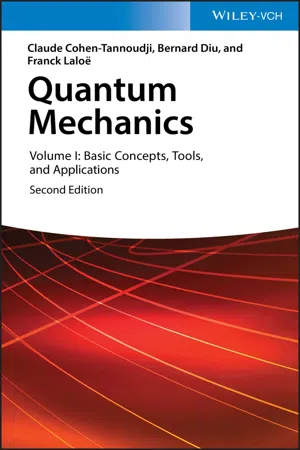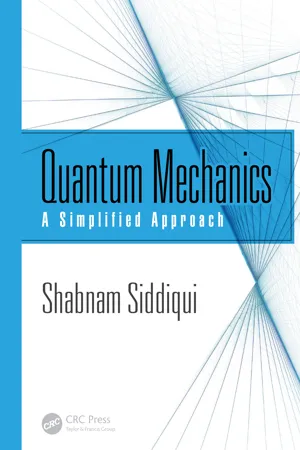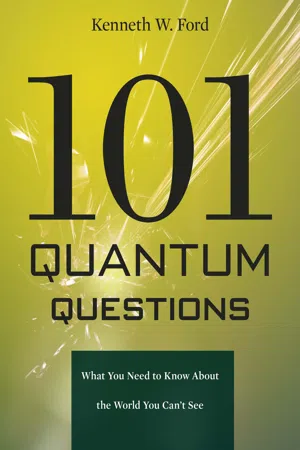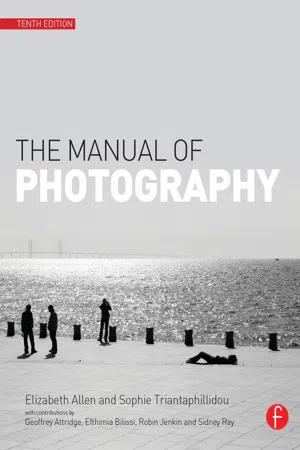Physics
Wave-Particle Duality
Wave-particle duality is a fundamental concept in quantum mechanics, stating that particles such as electrons and photons exhibit both wave-like and particle-like behavior. This means that they can display characteristics of both waves and particles depending on the experimental setup. The concept challenges classical physics' distinction between particles and waves, and is essential for understanding the behavior of subatomic particles.
Written by Perlego with AI-assistance
Related key terms
Related key terms
1 of 4
Related key terms
1 of 3
9 Key excerpts on "Wave-Particle Duality"
- eBook - ePub
- Zbigniew Ficek(Author)
- 2017(Publication Date)
- Jenny Stanford Publishing(Publisher)
Chapter 6 Duality of Light and MatterIf all this damned quantum jumps were really to stay, I should be sorry I ever got involved with quantum theory.—Erwin SchrödingerWe have already encountered several aspects of quantum physics, but in all the discussions so far, we have always assumed that a particle, a photon in particular, is a small solid object. However, quantum physics as it developed in the three decades after Planck’s discovery, found a need for an uncomfortable fusion of the discrete and the continuous. This applies not only to light but also to particles. Arguments about particles or waves gave way to a recognized need for both particles and waves in the description of radiation. Thus, we will see that our modern view of the “true nature” of radiation and matter is that they have a dual character, behaving like a wave under some circumstances and like a particle under other, but never both simultaneously.In the last few chapters, we discussed the wave and particle properties of light, and with our current knowledge of the radiation theory, we can recognize the following wave and particle aspects of radiation:The fact that the same light beam can behave like a wave and a particle raises tricky questions. How can light be a wave and a particle at the same moment? Is a photon a particle or a wave? Evidently, we are left with an obvious question: Which theory are we to believe? If we accept the duality of light, then another obvious question arises: Is this dual character a property of light alone or of all structures in the universe, in particular material particles? Following this, one may ask: Is an electron really a material particle or is it a wave?Wave characterParticle character1. Polarization Photoelectric effect 2. Interference Compton scattering 3. Diffraction Blackbody radiation We have to say that there is no definite answer to these questions. We can get a satisfactory answer to these questions, but we must enter the strange and often deceiving world of quantum wave physics - eBook - ePub
- Daniel D. Pollock(Author)
- 2020(Publication Date)
- CRC Press(Publisher)
CHAPTER 2Waves and Particles
2.1 INTRODUCTION
Einstein assumed duality between radiation and particles (Section 1.4 ). Experiments involving electrons and diffraction effects are described to illustrate such behaviors. These show the need for the statistical treatment of electrons.Classical physics and Einstein’s findings unmistakably demonstrated that light possessed both wave and particle properties. If light is corpuscular in nature, how can diffraction phenomena be explained? This question could be resolved if it were assumed that the waves and particles were associated in some way. It had already been assumed by Einstein and others that photons, wave quanta, etc., had energies that correspond to their frequencies: E = hv. The nature of this wave-particle relationship and its consequences are considered in this chapter.To understand their nature, the optical properties of electrons (similar to those properties employed in electron microscopes) are used to show some of the reactions of electrons of significance.2.2 ELECTRON OPTICS
The responses of electrons in electric and magnetic fields are evidence for their existence as charged particles. They move in straight lines in electric and magnetic fields, and their direction of motion changes when the strength of the electric fields change, neglecting magnetic fields. Under these conditions, electron beams may be considered to be matter waves that obey the laws of geometric optics. They can be made to act so that they reflect and refract. Consider Figure 2-1 , in which the refraction of electrons is simulated. Electrons from the source enter chamber 1, across which is a uniform potential V1 . They pass through the opening between the evacuated chambers and enter chamber 2. This chamber has another higher uniform potential V2 > V1 , across it. The two different electric fields set up by these potentials impart different velocities to the electrons, vP1and vP2, respectively. The direction of motion of the electrons changes when they enter the second, stronger field. This is the only effect of the potentials that must be considered here. The velocity components of the electrons perpendicular to each of the applied fields, vy - David Prutchi(Author)
- 2012(Publication Date)
- Wiley(Publisher)
Light apparently is something different altogether, but it behaves as a wave when the experiment is designed to reveal its wave-like properties, while it behaves as a particle when the experiment is designed to show its particle-like properties. This schizophrenic personality of light is known as the “wave–particle duality.” The type of experiment will show either light’s particle-like or wave-like behavior, but not both at once, which made Niels Bohr state that the wave and particle aspects of light are complementary to each other. The concept of complementarity derives directly from wave–particle duality, and states that all physical reality is determined and defined by manifestations of properties that are limited by trade-offs between complementary pairs of these properties. MATTER WAVES Even in the light of the Compton Effect, critics of the early single-photon interference experiments dismissed the importance of the observation by noting that a photon doesn’t have mass. Through some fancy hand-waving, they argued that the low-light interference could be caused through splitting and recombining the light quanta’s wavefront. Decisive proof would come when particles with mass would show interference. In 1924, French physicist Prince Louis-Victor de Broglie (pronounced “de Broy,” and by the way, he did belong to the French royalty) proposed that maybe it’s not just light that has this dual personality, maybe it’s everything! He reasoned that if the quanta of light could be both a wave and a particle, then maybe the same could be true of electrons. Remember that although a photon doesn’t have mass, it does have momentum p given by: De Broglie’s hypothesis was that matter—which is commonly described by our perception as “solid”—can also behave as a wave- eBook - ePub
- John D. Cutnell, Kenneth W. Johnson, David Young, Shane Stadler(Authors)
- 2018(Publication Date)
- Wiley(Publisher)
CHAPTER 29Particles and WavesThis photograph shows a highly magnified view of a female mosquito, made with a scanning electron microscope (SEM). In the twentieth century, physicists were astonished when it was discovered that particles could behave like waves. In fact, we will see in this chapter that there is a wavelength associated with a moving particle such as an electron. The microscope used for the photograph takes advantage of the electron wavelength, which can be made much smaller than that of visible light. It is this small electron wavelength that is responsible for the exceptional resolution of fine detail in the photograph.LEARNING OBJECTIVES
After reading this module, you should be able to…- 29.1 Define Wave-Particle Duality.
- 29.2 Explain the origin of Planck's constant from blackbody radiation.
- 29.3 Use photon energy to explain in detail the photoelectric effect.
- 29.4 Use photon momentum to explain in detail the Compton effect.
- 29.5 Solve problems involving the de Broglie wavelength of a particle.
- 29.6 Calculate quantum uncertainty using the Heisenberg uncertainty principle.
29.1 The Wave–Particle Duality
The ability to exhibit interference effects is an essential characteristic of waves. For instance, Section 27.2 discusses Young's famous experiment in which light passes through two closely spaced slits and produces a pattern of bright and dark fringes on a screen (see Figure 27.3 ). The fringe pattern is a direct indication that interference is occurring between the light waves coming from each slit.One of the most incredible discoveries of twentieth-century physics is that particles can also behave like waves and exhibit interference effects. For instance, Interactive Figure 29.1 shows a version of Young's experiment performed by directing a beam of electrons onto a double slit. In this experiment, the screen is like a television screen and glows wherever an electron strikes it. Part a of the drawing indicates the pattern that would be seen on the screen if each electron, behaving strictly as a particle, were to pass through one slit or the other and strike the screen. The pattern would consist of an image of each slit. Part b - eBook - ePub
- A.P. French(Author)
- 2018(Publication Date)
- Routledge(Publisher)
3 Wave-Particle Duality and bound states 3.1 PRELIMINARY REMARKSIn Chapter 2 we described the theoretical and experimental bases for ascribing a definite wavelength to particles of a given momentum. This development involved the recognition of some very basic similarities between the descriptions of light propagation and the motion of material particles. We shall now take up the question of what sort of wave equation can be devised for material particles that will embody these similarities and enable us to extend particle dynamics into the atomic domain.Our starting point is the knowledge that light waves are characterized by two parameters—wavelength λ and frequency v. The description of light as photons relates these classical parameters to the quantized values of energy E and momentum p for individual photons:λ =h p;E = h vNow in Chapter 2 we saw that the first of these relationships applies to material particles as well as to photons. Our next step is to introduce the postulate that the second relationship is equally general, so that the motion of a particle of momentum pand energy E will be described by a wave of wavenumber k and angular frequency ω, where=k ==2 πλ;2 π phω = 2 π v2 π EhIf we can find the value of E in any given case, we can, according to this new postulate, infer the value of ω through the relationshipE =hω = ℏ ω2 π(3-1) Recall (Eq. 1-29 ) that the symbol ħ is an abbreviation for h/2π. Using this same notation, the original de Broglie relationship for moving particles can be writtenp = ℏ k(3-2) Equations 3-1 and 3-2 will be the basis for constructing an equation for particle waves.Any wave equation that we develop must embody the correct dynamical relationship between E and p. In classical (nonrelativistic) mechanics, this relationship comes directly from the statement that the total energy of a particle is the sum of its kinetic energy p2 /2m and its potential energy V - eBook - ePub
Quantum Mechanics, Volume 1
Basic Concepts, Tools, and Applications
- Claude Cohen-Tannoudji, Bernard Diu, Franck Laloë(Authors)
- 2020(Publication Date)
- Wiley-VCH(Publisher)
Chapter I Waves and particles. Introduction to the fundamental ideas of quantum mechanics- A Electromagnetic waves and photons
- A-1 Light quanta and the Planck-Einstein relations
- A-2 Wave-Particle Duality
- A-3 The principle of spectral decomposition
- B Material particles and matter waves
- B-1 The de Broglie relations
- B-2 Wave functions. Schrödinger equation
- C Quantum description of a particle. Wave packets
- C-1 Free particle
- C-2 Form of the wave packet at a given time
- C-3 Heisenberg relations
- C-4 Time evolution of a free wave packet
- D Particle in a time-independent scalar potential
- D-1 Separation of variables. Stationary states
- D-2 One-dimensional “square” potentials. Qualitative study
In the present state of scientific knowledge, quantum mechanics plays a fundamental role in the description and understanding of natural phenomena. In fact, phenomena that occur on a very small (atomic or subatomic) scale cannot be explained outside the framework of quantum physics. For example, the existence and the properties of atoms, the chemical bond and the propagation of an electron in a crystal cannot be understood in terms of classical mechanics. Even when we are concerned only with macroscopic physical objects (that is, whose dimensions are comparable to those encountered in everyday life), it is necessary, in principle, to begin by studying the behavior of their various constituent atoms, ions, electrons, in order to arrive at a complete scientific description. Actually, there are many phenomena that reveal, on a macroscopic scale, the quantum behaviour of nature. It is in this sense that it can be said that quantum mechanics is the basis of our present understanding of all natural phenomena, including those traditionally treated in chemistry, biology, etc...From a historical point of view, quantum ideas contributed to a remarkable unification of the concepts of fundamental physics by treating material particles and radiation on the same footing. At the end of the nineteenth century, people distinguished between two entities in physical phenomena: matter and radiation. Completely different laws were used for each one. To predict the motion of material bodies, the laws of Newtonian mechanics (cf. Appendix III) were utilized. Their success, though of long standing, was none the less impressive. With regard to radiation, the theory of electromagnetism, thanks to the introduction of Maxwell’s equations, had produced a unified interpretation of a set of phenomena which had previously been considered as belonging to different domains: electricity, magnetism and optics. In particular, the electromagnetic theory of radiation had been spectacularly confirmed experimentally by the discovery of Hertzian waves. Finally, interactions between radiation and matter - eBook - ePub
Quantum Mechanics
A Simplified Approach
- Shabnam Siddiqui(Author)
- 2018(Publication Date)
- CRC Press(Publisher)
2 An Introductory History of Quantum Mechanics-II 2.1De Broglie Matter WavesIn the last chapter the experiments that led to key understandings concerning the characteristics of radiation were elucidated to explain that it has a discrete energy or it behaves as a particle. The black body radiation and photoelectric effect experiments demonstrated that electromagnetic radiation such as light behaves as a particle. Long before Planck’s discovery, it was established by experiments on interference, diffraction and many other phenomena in optics that radiation is a wave. This new discovery was contrary to this well-established belief about radiation. Does radiation have a dual nature? In some experiments radiation behaved as a wave and in some experiments, it behaved as a particle. Why? What are the underlying causes for such behavior? If radiation can behave as a particle, what about the behavior of material particles? These questions were greatly puzzling to scientists during the beginning of the nineteenth century.In 1924 Louis De Broglie tried to answer these questions and proposed a hypothesis which would form the basis of his Ph.D. thesis. De Broglie suggested that this dual nature of radiation may exist for matter particles as well. That is, material particles would also exhibit wave properties. At that time, the wave nature of material particles was not known. His idea was very original. Why was such wave aspect of material particles never revealed in any experiments before the advent of quantum theory? De Broglie suggested this could have been because the wavelength of material particles was so small that more sensitive devices than were available at the time would have been required to detect their existence. He developed a mathematical theory of matter waves that explained the behavior of such waves and the phenomena exhibited by them.De Broglie began with an examination of the behavior of a particle moving freely in space. Such a particle whose mass is “m 0 ” would move in a straight line with a constant speed “v - eBook - ePub
- Kenneth W. Ford, Paul Hewitt(Authors)
- 2011(Publication Date)
- Harvard University Press(Publisher)
section XI Waves and Particles64. What do waves and particles have in common? How do they differ?At first thought, it might seem that waves and particles have next to nothing in common. Waves are spread out over space and have nebulous boundaries. You can’t say that a wave is “at that spot.” Particles, by contrast, are little nuggets with well-defined boundaries—or perhaps, if they are leptons or quarks, with no physical extension at all. Particles have mass. We don’t usually assign mass to a wave. Waves are characterized by wavelength, frequency, and amplitude, concepts that have no obvious counterpart for particles. Waves can diffract (bend around corners) and interfere (reinforce or cancel one another), behaviors not expected of particles. Indeed, the demonstrated interference of light in the early nineteenth century convinced scientists that light is made of waves, not particles.Yet, if you think about what waves can do, you begin to see things they have in common with particles. Waves, like particles, can possess energy and momentum and can transmit these quantities from one place to another. Like particles, they move at a certain speed. Moreover, waves can be at least partially localized—that is, to have boundaries, even if the boundaries are not quite sharp. The vibrating air in an oboe is more confined than the air in a bassoon, which in turn is more confined than the air in a large organ pipe. Or think of yourself and a friend holding the two ends of a stretched-out rope (see Figure 41 ). If you snap your end, a localized wave pulse runs down the rope. It transfers an impulse to your friend’s hand, just as if you had thrown a ball to her.FIGURE41 A wave pulse, like a particle, carries energy and momentum from one place to another.The marriage of wave and particle came with Einstein’s corpuscle of light (the photon). It was, for a long time, a union blessed by very few scientists. From 1905 until the mid-1920s, the idea that light could be both wave and particle was too much for most scientists to swallow. Compton’s 1923 experiments on the scattering of X-rays by electrons in atoms convinced some. Bose’s derivation of Planck’s radiation law convinced others. Proof positive came in 1927 when Clinton Davisson and Lester Germer, working at Bell Labs in the United States, and, independently, George Thomson (son of J. J., the electron’s discoverer), working at Aberdeen University in Scotland, found that electrons striking the surface of a solid crystalline material exhibited diffraction and interference effects (see Figure 42 - eBook - ePub
- Elizabeth Allen, Sophie Triantaphillidou(Authors)
- 2012(Publication Date)
- Routledge(Publisher)
The existence of a threshold frequency for each metal can be explained by the work function of the material; the minimum photon energy capable of causing the photoelectric effect will eject the electron with zero kinetic energy. The photoelectric equation becomes:where v0 is the threshold frequency.The existence of light in quantities called photons provided solutions to the problems raised by the photoelectric effect that classical wave theory had failed to explain. Einstein’s work was a theoretical treatment and caused much controversy at the time, appearing as it did to contradict the wave theory of light based upon Maxwell’s equations for electromagnetic waves and, perhaps more fundamentally, the idea that energy was not something that could be divided into infinitely small units, i.e. continuous in nature.It was not until 1915, with the work of Robert Andrews Millikan, that Einstein’s theory was shown to be correct: Einstein had predicted that the energy of the ejected electrons would increase linearly with the frequency of the radiating light and Millikan was able to demonstrate this linear relationship experimentally. The work on the photoelectric effect had turned the world of physics on its head, resulting in the introduction of the concept of the duality of light: that it exhibited the characteristics of both waves and particles in different circumstances. Wavee particle duality would eventually be extended to other elementary particles such as the electron.THE PHOTON
A photon is a single quantum of energy that can only exist at the speed of light. It is the fundamental element carrying all electromagnetic radiation. It is indivisible, it cannot be split into smaller units, and is a stable, elementary particle. Photons differ from other elementary particles such as electrons in that they have zero mass or electric charge and consist purely of energy. When many photons are present, for example in a light beam, their numbers are so large that the inherent discontinuity or granularity of the light beam disappears and it appears as a continuous phenomenon. The photon can exhibit wave-like behaviour, resulting in phenomena such as refraction or diffraction, described earlier in this chapter. It also behaves as a particle when interacting with matter at a subatomic level, exchanging energy in discrete amounts. The amount of energy E (from Planck’s Law) exchanged during such an interaction is dependent on the frequency of light, and is known as the photon energy
Index pages curate the most relevant extracts from our library of academic textbooks. They’ve been created using an in-house natural language model (NLM), each adding context and meaning to key research topics.
Explore more topic indexes
Explore more topic indexes
1 of 6
Explore more topic indexes
1 of 4

